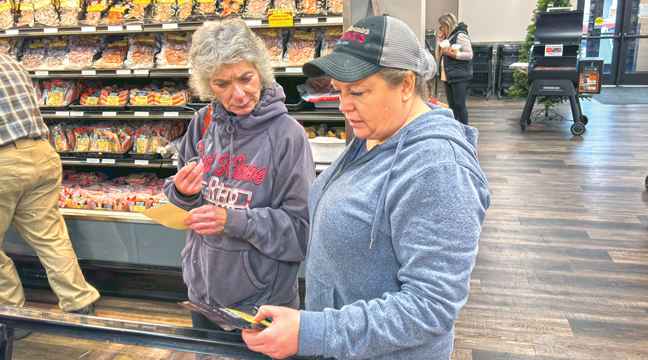Wednesday afternoon, Keith Parker, Erica Hoagland and Greg Russel of the Minnesota DNR stepped into the Sherburne County Commissioners Chambers for a workshop with residents from Orrock Township on their plan for managing the Sand Dunes State Forest.
At the end of the meeting, the DNR promised to improve communications with Orrock residents but made no promise to change their plan.
The situation arose after the DNR sent letters to some Orrock residents, explaining their plans to clear cut pine in certain areas and foster the growth of oak trees in an effort to return the area to pre-European settlement status.
Joining them at the table were State Senators Mary Kiffmeyer and Sondra Erickson and Dist. 15B Rep. Jim Newberger.
“This is in my district,” Newberger said. “And I am on the environment and natural resources committee.”
Sand Dunes History
Of the 11,040 acres of land in the Sand Dunes State Forest, 5,500 acres are actually owned by the state. Prior to 1950s settlement, the land was mostly covered by prairie and oak trees.
The settlers cultivated the land, planting small grains, corn, potatoes and hay. Then came the 1930s, the dust bowl and the Great Depression, followed by the war.
Tree planting began in the Sand Dunes in the early 1940s to stabilize the soil. Norway Pine grew easily in the light, sandy soil. It became a civic project. Everyone who lived in the area back then planted their share of pines, from girl scouts to CCC workers.
In 1943 Ray Clement introduced a bill to the Minnesota Legislature proposing that sections 16 and 36 and the NW 1/4 of section 22 (now the Ann Lake Campground) be set aside for conservation.
The bill passed, and Sand Dunes State Forest was created. In 1951 it was expanded to its present size of 10,698 acres (approximately 17 square miles). There are over 2,190 acres of Norway pine planted in the Sand Dunes State Forest and 605 acres of white pine. There are also 1,160 acres of School Trust Fund Lands the DNR is mandated to manage to generate revenue for schools.
Rare Ecosystem
The sand dunes are a rare ecosystem with some unique special features, Hoagland said. She specializes in endangered species and protecting habitat. The dry, barren oak savanna contains the most imperiled upland native plant community in the Midwest.
“Only 0.02% of pre-settlement acreage remains,” she said. “It is home to nine varieties of rare plants and 16 varieties of rare animals.”
Because of the rare and distinct ecological and geological features that occur within Sand Dunes State Forest, the DNR Divisions of Forestry, Ecological and Water Resources, and Fish and Wildlife reached an agreement in April, 2010 to protect and restore these unique natural features in selected areas of the forest.
These areas will be restored to an approximation of pre-settlement vegetation and permanently managed for rare plant and animal species including oak savanna, prairie, oak woodland, tamarack swamp, emergent marsh and sedge meadow.
Rare species living in the area include the plains hog-nosed snake, the gopher snake, lark sparrow, Eastern towhee, Northern barrens tiger beetle and the Leonard’s skipper butterfly.
The DNR has always harvested trees within the state forest but recently a couple of things have changed. One is they used to wait until stands of pine were 90-120 years old before harvesting them.
However, since the pines grow more slowly in their last years, the DNR now says it is more cost efficient to cut them earlier, after 60 ot 70 years.
“The legislature directed us to re-evaluate how we generate funds from school trust lands,” Russel said.
The funds generated for education go into a general fund and shared between all the schools in the state. Timber sales make up about 20% of the income generated from school trust lands. Mineral sales make up 80%, Russel said.
Some of the stands will be clearcut and left to regenerate as pine or oak. Some will be replanted to continue to generate income. Others will be restored to oak savanna.
“The goal is to get away from pine management,” Russel said.
Newberger asked how much revenue was generated for schools from the timber sales and Russel said he did not know. The DNR portion he estimated to be $4 million. Newberger asked Russel to send him more information.
Protected Species
Clearcut forest looks ugly and it will look ugly for a long time to come as oak trees grow slowly, reducing property values for homeowners, who in same cases, planted the forest they live in.
Commissioner Rachel Leonard said she was glad the DNR was interested in saving rare species, however, their studies failed to take into account one specimen which also inhabits the Sand Dunes.
“It’s the people,” she said. “I resent the fact there is no appeal process. As commissioners, you can change that,” she said. “People are losing money but not the DNR. It makes me wonder how it is spent.”
Turning to the Orrock Township residents, Leonard drew a round of applause when she said, “You are not protected. You are the taxpayer, not the butterfly.”
Residents meanwhile urged the DNR to avoid clear cutting right before hunting season, not to burn poison ivy because the oils can spread through the smoke and make people sick, and not to use the harsh chemical weed killer they are proposing to use because it is not recommended for use in sandy soil or close to homes.
“It is not a joke,” said Don Bouley, longtime Orrock resident.
“It goes into the ground and contaminates the ground water,” said Heather Carlson. “We all have our own wells out there. The last time you burned, I got so sick.”
Hoagland also dismissed the idea of another dustbowl.
“That was after a prolonged period of drought and because of all the farming,” she said. “The natural ground cover will protect against it.”
The meeting broke up after the county commissioners had to attend to another matter, but not before Parker promised to be more forthcoming with information, including sending letters to all Orrock Township residents and attending a meeting of the Orrock Township Board of Supervisors in the near future, something they have not done in the past.
“Clearly we need to do a much better job of communicating,” said Parker. “We welcome this opportunity to hear from you.”







